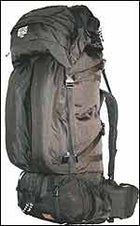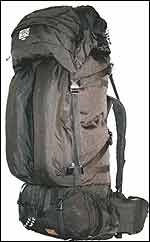Well, I don’t think anybody is making a Ruptured Disc Edition Backpack, but certainly some are going to be better than others. I worry about the weight you’ll need to carry for a long trip—more than 40 pounds, I would imagine. In my view you’d be well advised to take your pack in to see your doc, just so he/she is perfectly aware of what you propose.
 G-6000
G-6000
That said, you’ll want a pack that has the most supportive suspension you can find. I’m sure your doctor would concur that the trick is to keep weight off your back and shoulders, any compression of your discs being likely to exacerbate your problem. That means a hefty suspension that can be adjusted so that a lot of the weight is transferred to the hips. One leading candidate would be the Mystery Ranch G-6000, the latest creation from master pack maker Dana Gleason (of Dana Designs fame). This is a big pack that will remind people of Gleason’s terrific Terraplane (still my main “big” pack after 15 years). Load control is fabulous, and a 50-pound load will feel like 30. The downside is the price: $497 (www.mysteryranch.com). That’s because of the G-6000’s premium materials, plus the fact it’s sewn in the U.S.
If that’s a bit rich, Gregory’s Whitney ($339; www.gregorypacks.com) offers similar load-bearing capacity in a more reasonably priced pack. It has a wonderful suspension that combines a framesheet with pack stays to give the pack lots of load-transfer capabilities. And it has a voluminous bag (5,450 cubic inches in medium) that’s more than adequate for long trips.
A third strong candidate is the Osprey Crescent 85 ($379; www.ospreypacks.com). Osprey packs have top-notch suspensions, and the redesigned Crescent 85 even allows for custom molding of the hipbelt, something that might be a real benefit for you. Aluminum stays also help keep the pack from collapsing around its load, which lesser packs can do.
As I always say, buying packs is like buying shoes—fit counts. So take the time to try on several packs. And I hope the trip goes well!
Pick up a copy of the 2006 şÚÁĎłÔąĎÍř Buyer’s Guide, on newsstands April 25, for a look at 396 torture-tested products, including the 2006 Gear of the Year award winners and an all-new women-specific review section.


